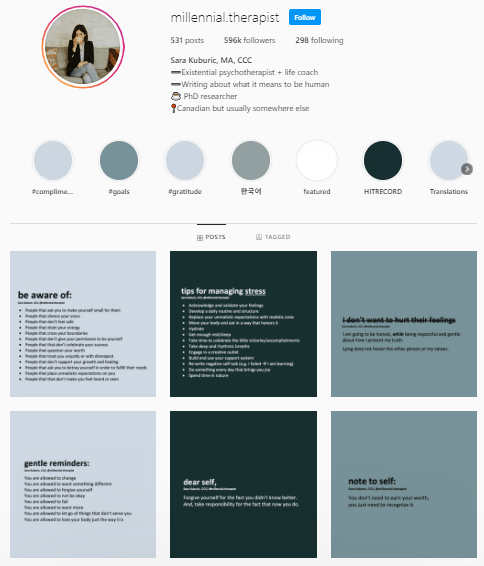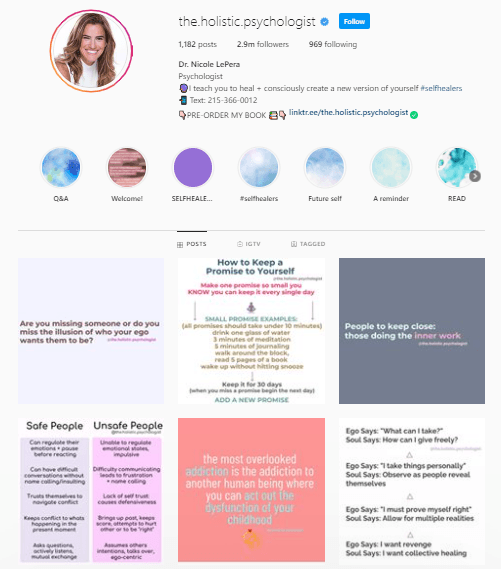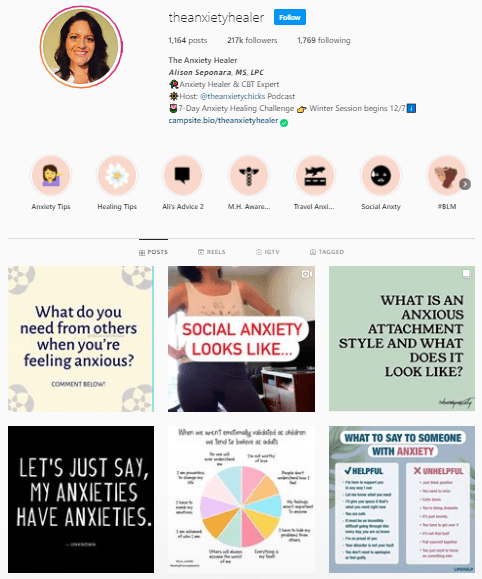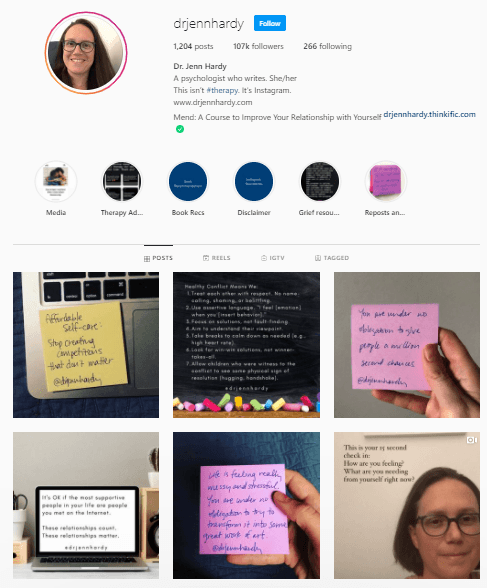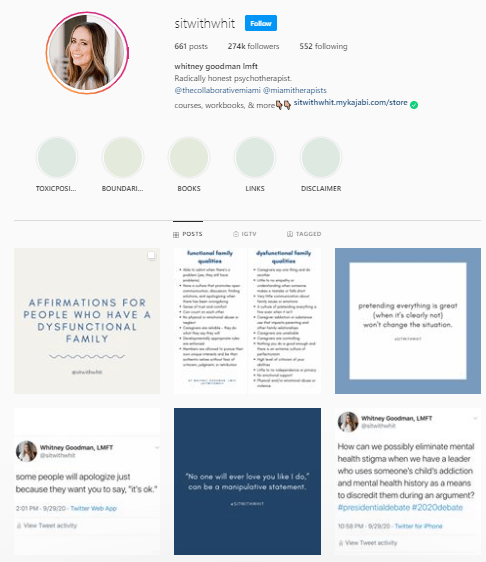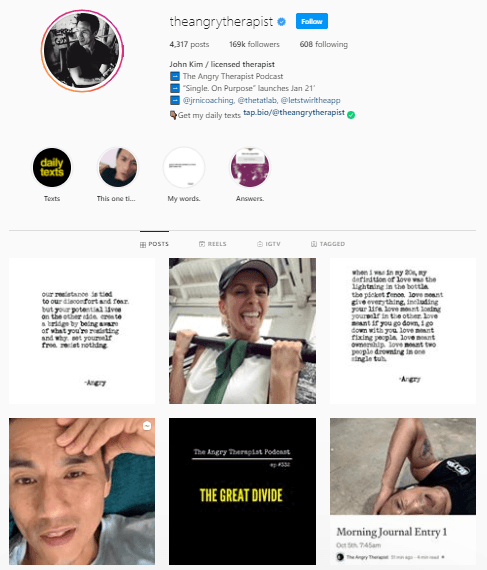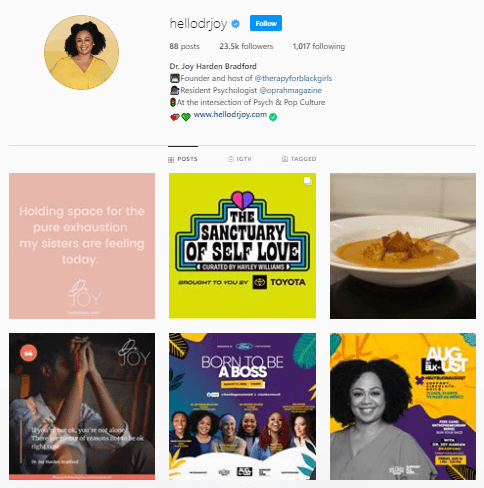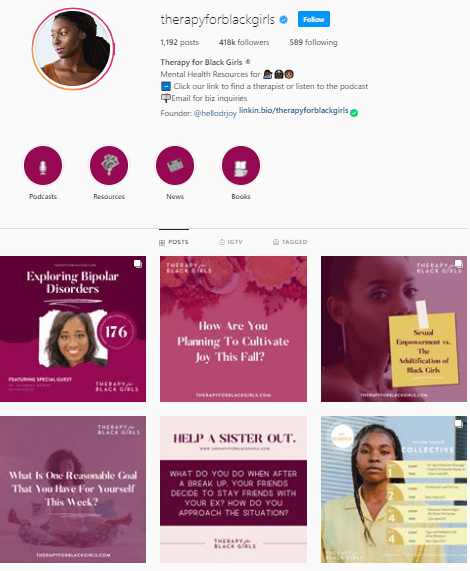Creating a Social Media Presence for Therapists
Table of Contents
Navigating social media presence is a tricky business when you’re a counselor or a therapist. A million questions come to mind when considering creating a social media account for your practice. Most of the time, the answers are hard to come across, mainly because it’s such a recent tool for therapists to advertise themselves.
Besides being a great resource to captivate new clients (after all, practitioners are business owners like any other!), these accounts also have great potential of helping people through advice and self-help tips and connect you to other professionals in your field!
Having a business profile online is especially important in a time like this, where online sessions are becoming more and more common due to the pandemic and to the ever-evolving technology.
In this article, we’ll show you that the process of gaining and maintaining your social media presence doesn’t have to be so full of doubts and conflicts; instead, it’s possible to help your business grow in an engaging, educational and ethical way.
Social Media Platforms and how to pick them
Picking a platform is the first step to take when considering entering the social media universe as a therapist. Bear in mind that we mean any platform that allows people to interact with each other by creating, sharing, and exchanging information by social media. Here, we’ll take a closer look at the following: Facebook, Instagram, Twitter, Linkedin, and Youtube.
Before doing that, we advise you to start slow – you don’t want to bite off more than you can chew. Frequency is an essential thing on social media (as we’ll discuss later), so it can be overwhelming to administrate more than one or two accounts at once. The most common and mainstream platforms are Instagram and Facebook, so it’s a good idea to start there.
Also, picking a platform you’re comfortable with is an excellent way to begin your social media journey – but keep in mind that every platform has a learning curve and that they’re made to be intuitive! So don’t be afraid to explore other platforms you might not master yet.
At last, we offer you insight into what are the pros and cons of each platform.
Pros:
- Has a more extensive user base than all the others – it’s expected to reach 1.69 billion users in 2020!;
- It’s easy to engage with people you already know, and the Facebook algorithm helps with that;
- It’s easy to post and repost content, as it allows for various formats of posts.
Cons:
- It’s challenging to reach a larger number of people since Facebook’s algorithm makes it hard for your posts to appear on someone’s wall, prioritizing posts by friends and most interacted with pages;
- To have a good reach, it takes a lot of likes, comments, and shares.
Pros:
- It offers excellent reach, especially if people engage with your posts, captivating potential clients;
- It’s trending and really in use today (With a New York Times article even claiming that Instagram therapists are the new Instagram poets!);
- Allows for various formats of posts, such as videos, cards, and text;
- It’s possible to use hashtags to attract people interested in your niche;
- You can use the Instagram Stories feature to offer real-time updates, engage with followers, and post short videos.
Cons:
- Using it to captivate new clients is more of a long-term strategy;
- You need to create very engaging and captivating content to hold users’ attention, involving much time and effort.
Pros:
- You can take part in conversations and threads;
- You can target exchanges by using hashtags;
- You can easily tweet and retweet;
- Writing content for Twitter is not as challenging nor as time-consuming.
Cons:
- To be relevant on Twitter, you need to post continually, and your tweets might get lost in the middle of others;
- There’s a word limit, so you have to write shorter and more compelling posts, meaning that it can be too superficial, depending on the topic.
Youtube
Pros:
- It’s one of the biggest search engines platforms;
- Posting videos of you and about you can be a great way of creating credibility and getting potential clients to trust you;
- You can embed YouTube videos on your other accounts or your blog;
- People don’t need to be registered on the platform to watch your videos.
Cons:
- It’s harder to reach potential clients and people that don’t already know you;
- The only format of posting is video, which usually requires more time and prep.
Pros:
- You can use it to network with other mental health professionals and potential partners;
- LinkedIn Groups is an excellent way of finding clients that are interested in your practice.
Cons:
- The interaction with clients is minimal, as it’s more of a networking platform;
- The type of content can be restricting.
Before making any decisions about where to open an account, consider your niche and what type of people you want to reach. Do you work more with adolescents and young adults? Then maybe prioritize Instagram. Are your patients mainly adults? Then Facebook might be the best choice for you. Either way, make sure to put thought into what will benefit you the most!
- References
- ‘Which Social Media Platforms Should You Use for Your Therapy or Holistic Practice?’ by Juliet Austin
- ‘Choosing the Right Social Media Platform for Your Business’ by Accion
- ‘What Social Networking Platform is Right for Me?’ by Therapy Everywhere
- ‘How to Market Yourself as a Therapist Using Instagram’ by Private Practice Skills
Frequency of posting
Frequency of posting is crucial to your social media accounts’ success, since you don’t want to over-post and flood your followers’ feed, nor do you want to post too infrequently and let your followers forget you’re even there.
The best path to determine your posts’ frequency is to understand your followers and how much they engage with you. If they’re highly active, a higher frequency of posting is requested; on the other hand, if they’re not as in touch with social media, you don’t need to release as much content.
With that in mind, it’s also important to consider that quality is always better than quantity! It serves you no purpose to have an active social media presence and only repost from other accounts or post low-quality content, so make sure to prioritize original and well-thought-out posts.
So, in general, what is the recommended frequency to post on each platform?
To start, we’ll discuss Facebook. HubSpot found that pages with more than 10,000 followers were the only ones that saw more engagement when increasing the frequency of posting; pages that had fewer followers than that, when posting more than two times a day, saw the number of clicks per post decrease.
From that, we can conclude that the optimal frequency of posting on Facebook is 1-2 times a day, with the bare minimum being once a week; again, it all depends on your audience.
On Instagram, it’s super important to establish a pattern to keep your followers engaged; for example, if you regularly post two times a week, you may run the risk of losing followers if you suddenly start posting every day.
As well as on Facebook, the optimal frequency is that of 1-2 times a day, with the bare minimum being once a week.
The rules are different for Twitter because tweets tend to disappear from people’s feed quickly.
Once again, it all depends on your followers’ engagement, but tweeting once a day is the lowest you can go without losing their attention, and you can go as high as 23 tweets per day if you want to get a large number of responses!
On LinkedIn, it was found that anywhere from 2 to 5 times a week is a good choice, and publishing a second post on the same day can harm the reach of the first one.
Since LinkedIn is a business-centered platform, users usually share posts on weekdays.
YouTube
At last, we have YouTube. Normally, creating content for YouTube requires much more time and effort, but don’t let that scare you! One alternative is to pre-record several videos in a row, so you can have a stash for when it’s time to post.
And about that, on this platform, the best is to post once a week, but it all hangs on the work you put into making your videos; perhaps the best choice for you can be to schedule a video every two weeks; only you know what’s best for you!
We recommend the blogs Hubspot, Neil Patel, and Louise Myers for more tips and strategies for digital marketing and social media advertising.
- References
- ‘How Often To Post On Social Media: 2020 Success Guide’ by Louise Myers
- ‘How to Get More Engagement on Social Media (Without Being Pushy)’ by Neil Patel
- ‘How Often Should I Post On Social Media For My Business’ by DigitalMarketing.org
- ‘How Frequently Should I Publish on Social Media? A HubSpot Experiment’ by HubSpot
What to post and what not to post
Now that we’ve discussed the where it’s time to focus on the what – your top priority in social media.
Like I’ve mentioned before, the platform you choose and the frequency of posting make a difference only to some extent, seeing as the type of content you’ll create and share is what’ll hook your followers!
As a therapist, it’s even more challenging to come up with content that is both pertinent and adequate, so next, we’ll walk through the dos and don’ts of posting as a therapist, taking a look into what you can (and should) post in your practice’s account, and what is best to leave to your personal profile.
What to post
Know your niche
Firstly, when creating a social media presence, you’ll need to answer a fundamental question.
What is your niche, the thing you want to be known for?
Your niche matters since it relates to how you market yourself, the type of followers you attract, and the type of content you create. For example, you may advertise yourself by your therapy orientation (psychoanalysis, Gestalt, systemic), the kind of disorders you treat (depression, anxiety, personality disorders), a specific age demographic (pre-teens, elderly), or by a combination of all of those!
Defining your target demographic is also an essential step to choosing a social media platform, as we’ve mentioned before. Knowing your age demographic will indicate what platform is the best pick for you since some platforms work better for specific groups. To illustrate, if you work with adolescents, Instagram is the way to go, and LinkedIn wouldn’t help you as much.
Understanding your target demographic also determines your branding, which in turn ultimately influences the style, format, and content of your posts; if you’re a child psychologist, you’re not going to work with a black and white color scheme or post mainly text.
Either way, with or without social media, I’m sure you already have a niche in mind; nevertheless, it’s essential to make the exercise of reflecting on what it is and what content is pertinent to it.
Get to creating
Once you’ve established your niche, it’s time to think about what kind of content you can create.
What kind of content should you share?
Create posts that are useful to people, such as advice and psychoeducation; when doing that, consider the needs and conflicts of the people you attend to (if your niche serves specific ages or treats particular disorders). For example, if you focus on adolescents, it might be a good idea to create a post about mental health and social media or vocational choice.
On the other hand, if you choose to brand yourself by your therapy orientation, a good option is to talk about your modality’s basic strategies and concepts. For instance, if you work with CBT, you can make cards explaining cognitive distortions or create an image explaining a step-by-step simple mindfulness exercise, followed by its benefits.
However, you don’t need to be restricted by your niche, as when your accounts take off, it’ll be hard to come up with content related only to it every week.
Content about general wellness is always welcome; another good idea is to address recent events and their impact on people’s mental health, suggest books and movies you might find useful, or share self-help tips.
Another suggestion for excellent and engaging content is to talk about yourself and your professional journey! The idea is not to discuss your personal life, but rather share information such as where you’ve graduated from and your specializations, why you chose this profession, or where you’ve worked.
Having a social media presence can help new patients feel more confident to reach out and trust that you can help them based on what you post, so discussing these topics is a fantastic way of connecting with them.
What are some must-haves on your account?
First of all, no matter what kind of content you come up with, always use a conversational and clear language, without any technical jargon and terms, which can confuse and discourage your followers.
Some other crucial actions to take in your social media account are to clearly state your contact information and location so that people quickly know where to reach you in case of potential clients and people who search your profile looking for help. Besides, we suggest linking your website (if you have one) and other business accounts on your bio to establish your presence and direct the traffic.
To conclude, it’s essential to be aware that social media is not only for self-promotion – nobody will keep up with your account if all you post are advertisements for workshops and events. These accounts have great potential to help and educate people, so make sure to engage with your followers.
Engagement
Engagement with your followers and, in turn, their engagement to you is a big part of creating a social media presence. Encouraging it is one of your tasks as a business (social media account) owner, so here are a few tips to create this movement:
- Be responsive to comments, shares, and messages;
- Post content that poses questions, generating responses and conversations;
- Create a post or a moment (if it’s on Instagram Stories) where people can ask you questions, and you respond with short personal answers followed by a subtle upsell, such as “If you need to talk more about this, send me a message so we can set an appointment. My clinic hours are….”
- Ask your followers what kind of content they would like to see on your account;
- Repost content by other therapists and practitioners, creating connections and, hopefully, partnerships.
If you want to learn and understand more about these issues, here are a few recommendations for you:
- Webinars about self-marketing for therapists
- 11 Facebook posts ideas
- Writing Blog Posts: 5 Ways Therapists Can Generate Ideas for Topics
- 50 Social Media Post Ideas for When You Don’t Know What to Post
- How to Market Yourself as a Therapist Using Instagram
And if you want to check out successful social media accounts by therapists for insight and inspiration, here’s a list:
Sara Kuburic
Instagram: @millenial.therapist
Dr. Nicole LePera
Instagram: @the.holistic.psychologist
LinkedIn: Dr. Nicole LePera
YouTube: The Holistic Psychologist
Dr. Joy Harden Bradford
Instagram: @hellodrjoy and @therapyforblackgirls (Founder)
What not to post
Maybe just as important as knowing what to post is knowing what not to post.
Depending on the type of content you share, you may drive followers away or look unprofessional. Having a social media presence as a therapist means not posting everything that comes to mind (or feed), and even avoiding specific topics.
For example, discussing ideologies or personal morals is not the way to go if you want to attract a wide range of clients and remain a blank slate in your practice. Because of that, it’s best to keep these topics to your private profile.
Other types of posts that are not adequate to share on professional accounts are random funny videos, memes, or other loose content that is not related to mental health or your practice. Besides flooding your follower’s feeds, it might look unprofessional.
Turning our discussion to privacy issues – which we’ll expand on later, you should never post personal details or information about clients, even if you change or don’t mention their names. That’s a significant break of trust and could have disastrous consequences.
Following the same line, you shouldn’t follow or send requests to your clients, even if it’s your professional account, as they may feel uncomfortable.
On a final note, we look at APA’s Ethics Code, which offers guidelines on ‘Advertising and Other Public Statements.’ You can check it out here in full, but in general lines, it states:
- Avoid false or deceptive statements;
- Beware of engaging others when it comes to promoting yourself;
- Accurately describe any Workshops and Non-Degree-Granting Educational Programs you’re promoting, informing educational objectives, the presenters, and the fees involved;
- When providing public advice or comment, it must be based on your professional knowledge; it must be otherwise consistent with the Ethics Code, and it shouldn’t indicate that a professional relationship has been established with the recipient;
- It’s not allowed to solicit testimonials from current therapy clients or other people.
Creating the content
When it’s time to create the content, some therapists may feel lost or frustrated, as creating engaging social media posts was not part of our curriculum!
But don’t give up before you’ve started – there are many great websites and apps out there that help you create attractive and educational content intuitively.
Suggested programs
- Canva (We recommend)
- Canva is a beneficial and complete graphic design platform that allows you to create an infinite number of visual content, providing templates for Instagram cards, presentations, posters, and many other formats. It’s free, but those that pay for Canva Pro get access to new elements and features. In our opinion, Canva is the Holy Grail of content creation – but if it doesn’t serve you, there are many more options out there!
- Powtoon
- Powtoon is a video creation tool that is easy to use, and that creates presentations, videos, and more. It offers different styles of animation, characters, and backgrounds. It’s free, but just as Canva, paying users get access to many other features.
- PicMonkey
- PickMonkey is a website that is both a photo editor and a design tool. It shares templates for different types of posts and documents, and it’s user-friendly. PicMonkey is also free but presents the option of purchasing PicMonkey Pro.
- Animoto
- Animoto is a free platform that allows you to produce videos, slideshows, and presentations from photos, video clips, and music. The templates they offer are easy to use, while also looking professional.
The format in which you’ll create the content varies from one social media platform to another, but there’s a large number of possibilities to choose from; there’s short videos (of you or anything else), short animations, quote pictures, informative cards, bullet points, gifs… No matter what you go with, avoid posting just plain text (Twitter excluded).
Some other platforms focus on design, branding, and digital marketing and provide more professional help regarding your social media strategy and digital marketing, such as Tailor Brands, Marketable, and Thrive Agency.
Time and Effort
Even though the tools listed above make creating content much more accessible, it’s still demanding, as producing original posts of quality takes time and effort.
It’s needed to come up with topics, thoroughly research it, resume it and write it in a clear language, and, lastly, arrange it all in a way that is both graphically appealing and easy to read. Phew!
One piece of advice we give is to prepare your content ahead of time – for example, in one week, produce posts that will last for the next month – arranging a schedule that works for you.
There are websites and apps like Tailwind, Later, and Hootsuite that help you in your planning and even automatically post for you!
All things considered, you need to respect yourself and your time: don’t set out to post original content three times a week, for instance, and end up having to compromise for low-quality content because you didn’t have enough time to develop it.
Virtual Assistants
It can be an excellent option for therapists that have the means to hire a social media manager or virtual assistant to help you create and post the content. They can help you research, create the content, organize a posting calendar, or come up with topics for you, which will save you a lot of precious time.
Hiring someone may seem strange or challenging at first, but there are some great platforms out there for you to choose the professional that best meets your requirements. Here are some of them for you to take a look.
Another good idea is to browse through LinkedIn and check out some profiles that might have what you’re looking for in a virtual assistant.
Paid Ads
Paid ads on social media are a smart way of advertising your practice and reaching more people without having to wear yourself out, since organic reach, unfortunately, doesn’t always give you the results you were expecting.
When that happens, it’s possible to advertise your profile on almost all social media platforms. The most common tool for that is Facebook Ads, but there are similar Twitter, LinkedIn, and Instagram options.
How do paid ads work?
First of all, when starting to use paid ads, begin small and see what works for you – then invest there. That way, you make sure that your money doesn’t go to waste. In regards to your investment, make sure to track your expenses versus your profit along the way.
Most platforms use a Pay Per Click (PPC) model, where you only pay if the user takes the action you want; one example of that is Google Ads. However, Facebook Ads uses a Pay Per Impression (PPI) model, which means that you’ll pay in proportion to how many times the ad is shown.
To guarantee that the right people will see your ad, platforms let you target it to a specific demographic!
Each social media platform offers different options to delineate your demographic, but common ones are location, age, and interests. That means you’re going to need to create a strategy to reach your niche.
The ethics of paid ads
Before posting any ad, you should ask yourself if the content is appropriate and if it’ll attract clients and followers for the right reasons.
It’s a good practice to review APA’s Ethics Code and make sure that you’re not disseminating inadequate content. Reviewing your country or state’s guidelines regarding ads is a good course of action as well.
Another wise approach is to get a second opinion from colleagues about the post’s tone and content. Here’s a simplified guide on the dos and don’ts for advertising your practice online for future reference.
Finally, consider paid advertisements not as substitutes to your posts, but as a boost – your ad is only as good as the quality of your content.
Here, you can find specific resources about Facebook Ads, Instagram Ads, LinkedIn Ads, and Twitter Ads.
References:
- ‘7 Reasons to Consider Paid Social Media Advertising’ by The Manifest
- ‘Social media advertising: how to run a compelling campaign’ by Sprout Social
- ‘Social Media Advertising & Paid Social Guide’ by Sprout Social
- ‘Beginner’s Guide to Paid Advertising for Therapists’ by Timewith
- ‘Have You Considered Advertising Your Services?’ by APA Services
Privacy and contact with clients
One of the most pressing matters for a clinician on social media is privacy and contact with their clients. The dilemmas surrounding this theme are still relatively unexplored, generating self-doubt and insecurity.
Nonetheless, we’ll dive into some of them and provide you with the security you need to navigate your social media account confidently.
Personal vs. Professional account
Our focus here is not to discuss the therapist’s personal accounts; regardless, it’s important to mark that you shouldn’t merely expand your personal account if you want to establish your social media presence. Rather, the way to go is to create a new account or, even better, a business account; most platforms allow you to choose between a personal and professional profile.
For example, suppose you want to enter Facebook. In that case, it’s possible to create a page for your private practice, which sends a different and more professional message than just creating a standard profile.
Here’s how you create a business account on Instagram, Facebook, and LinkedIn.
It’s also imperative to keep boundaries between your personal and professional social media presence, and the key to doing that is to discern what belongs to each account. Don’t post anything in your professional profile that could harm an existing or potential therapeutic relationship.
It was the article ‘Boon or bother? Social media marketing and ethics‘ that wisely stated that if it’s something that you wouldn’t say to a client or another counselor in “real life,” you shouldn’t post it.
Also, linking your personal account to your business account is not a suitable course of action, as having your clients on your personal accounts can be harmful and damaging to you both.
If you want to learn more or are experiencing doubts about these boundaries, the American Psychology Association (APA) released a useful guide for ‘Best Practices for an Online World.’
Existing clients and social media
Regarding your clients, it’s common to ask yourself if you should allow them or not in these accounts. As we’ve mentioned before, you should not follow them or send invites to like your page, since it can put them in an awkward position and, in turn, shake your therapeutic alliance.
However, differently than your personal account, your business account can be viewed as an extension of your practice, and it’s public for everyone to see, so clients can, at their own will, follow you or like your page. Even so, it’s crucial to inform them that they have a right to confidentiality, and by following you on social media, they’ll create a digital connection between you two.
In conclusion, it’s up to you to allow clients on your business pages, and up to them to choose to follow you or not – considering you let them.
This discussion takes us to the current and necessary practice of disclosing your social media policy to your client before starting your work with them. For maximum clarity, your policy should be written and cover:
- Your reasons for creating the social media policy in the first place, such as to protect yourself and your client;
- Your course of action in regards to friending, following, and following back, both on personal and professional accounts;
- Your channels of communication, and how clients can reach you;
- Your practice concerning reviews on business sites (if you allow it or not, and that you won’t engage if they make one).
One matter that should be considered further is that of your channels of communications.
Client Communication over Social Media
Conversations you have on social media are not entirely private, so personal matters shouldn’t be discussed there – that goes for both existing clients and potential clients.
In the first case, your social media policy should state that contacting you through social media is not okay and that you won’t respond if they do.
In the second case, people may come to you asking for help on these platforms; if that occurs, you should redirect them to an adequate communication channel and then make an appointment or redirect them to a proper place. For example, you may want to lead them to your website or e-mail to arrange a proper consultation.
Here are a couple of examples of written social media policies to better illustrate these practices:
- https://www.drkkolmes.com/docs/socmed.pdf
- http://laurenrigney.com/social-media-policy.html
- https://www.bridgecounseling.net/social-media-policy
In conclusion
Making a mark for your practice on social media is no easy feat, especially when there are so many different paths to take and ethical considerations to make.
However, we hope that with this beginner’s guide to social media as a therapist, we’ve clarified the doubts and fears that kept you from living your best modern therapist life!
Finally, don’t be afraid to go out there and make social media work for you while you work for people.
If you have any comments or suggestions, we’ll be glad to hear from you in our email. And if you’ve found this guide to be useful, share it with your colleagues and friends!
Made by Couch & Client.cc
Author: Renata Paese
Looking for other books or resources?
Check out the ones below, or click below to download all of the resources we have!
The 7 Books Every Therapist Must Read
After scouring many forums and reading many suggestions, these came up over and over again for therapists must reads. Below you will find 7 insightful,
Top 5 Podcasts to Grow Your Therapy Practice
Looking for great podcasts to listen to so you can grow your practice? Look no further these 5 podcasts are frequently posting, up to date and super helpful for all therapists.
